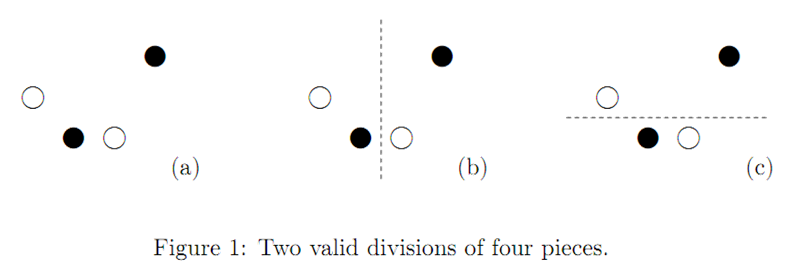1165 . Chocolate Pie Division
Description
Frans is celebrating his birthday. At an exclusive baker's shop, he has bought two delicious pies, of
different types. He cuts each pie into a number of pieces. At coffee time, he invites his colleagues
for a piece of pie, but after the celebration, some pieces are left over. In fact, 2N pieces are left
over: N pieces of each pie, and N happens to be even. Frans does not want to take all remaining
pieces back home, so he decides to share them with a colleague who is fond of pie too.
Now Frans wonders how to split the 2N remaining pieces, which seem to be randomly distributed
over the table, in two. A simple way to achieve this would be to stretch a cord over
the table, in a straight line. The pieces at one side of the cord are for Frans, the pieces at the
other side are for the colleague. There is, however, a constraint. Both Frans and his colleague
should take home N/2 pieces of the first pie, and N/2 pieces of the second pie. Is this possible with
the cord trick? And if so, how many ways are there to do this? Of course, this depends on the
positions of the 2N pieces on the table.
For example, let N = 2, and let the pieces of one pie be depicted by closed circles, and the
pieces of the other pie by open circles. In the configuration of Figure 1(a), there are two possible
divisions, as indicated in Figure 1(b) and Figure 1(c).

On the other hand, in the configuration of Figure 2(a), there is only one valid division, as
indicated in Figure 2(b).

To simplify things, we assume that no three pieces of pie are on the same line. This implies
in particular that no two pieces of pie occupy the same position. Moreover, we assume that each
piece is infinitely small.
Input Format
The first line of the input contains a single number: the number of test cases to follow. Each test
case has the following format:
- One line with an even integer N, satisfying 2 <= N <= 1000.
- N lines, each with two integers x and y, satisfying −10000 <= x, y <= 10000: the x- and
y-coordinates of a piece of the first pie. - N lines, each with two integers x and y, satisfying −10000 <= x, y <= 10000: the x- and
y-coordinates of a piece of the second pie.
Integers on the same line are separated by a single space.
Output Format
For every test case in the input, the output should contain a single number, on a single line: the
number of ways to split the 2N pieces of pie in two, by stretching a cord over the table, such that
at each side of the cord, there are N/2 pieces of the first pie and N/2 pieces of the second pie.
Sample Input 1
3 2 2 1 4 3 1 2 3 1 2 2 1 3 1 1 2 4 3 4 2 9 6 1 12 4 11 8 0 2 15 6 8 12 1 5
Sample Output 1
2 1 3
Hints
Problem Source
Migrated from old NTUJ.
BAPC 2010
Subtasks
| No. | Testdata Range | Score |
|---|